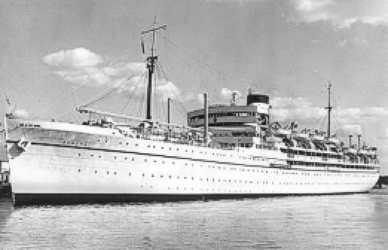|
Singapore
At the end of the summer Dick’s leave came to an end and he was one of a number of men who were the last peacetime draft of replacements and reinforcements to be sent to Singapore. This contingent of troops left Great Britain in September 1938 on the 12,615-ton troopship Dunera and arrived in Singapore on 20th October. The Dunera was a modern ship having been built the previous year; she had undertaken her maiden voyage to China in September 1937. The Second Battalion of the Loyals had transferred to Singapore early in 1938 following a tour of duty in Shanghai. Their stay in China had been rather eventful as it coincided with the Japanese attacks on the city as part of their campaign to annexe large areas of mainland China to form the puppet state which was the first part of their aggressive plan for domination of Asia. For those men serving with the regiment at that time it was to prove a foretaste of what was to come.
|

|
|
Troopship Dunera
|
|
When war began in Europe in September 1939 the Second Battalion of the Loyals was still stationed in Singapore where it was responsible for Beach Defence as a part of the Empire forces based in Malaysia. The declaration of hostilities prompted a brief flurry of activity and at 0800 hours on the morning of Monday the 4th September the Battalion’s advance party took up positions at Blakang Mati. Blakang Mati is a piece of land, an island in its own right, on the southernmost tip of Singapore Island. It is separated from the main island by the Kepel Harbour strait. At 1215 hours Battalion HQ closed down at their regular base at Gillman Barracks and, at 1330 hours, the rest of the Battalion marched off to join the advance party, arriving at Blakang Mati at 1415 hours.
For the next four days the Battalion busied itself with overhauling the defences at Blakang Mati. On Saturday the 9th September the Battalion returned to Gillman Barracks, having been relieved by 5/2 Punjabis. Dick and the rest of the HQ Company arrived back at barracks at approximately 1100 hours. After that initial burst of activity, things settled back to an almost peacetime routine.
Over the winter months of 1939 - 40 the Battalion war diary records little or nothing of a warlike nature. This was the time that in England was called the “phoney war” - Singapore’s version seemed more akin to “no war at all”. The first real stirrings of trouble were felt in June of 1940. As Britain faced possible invasion by German forces the authorities in Singapore were increasingly worried about the possibility of civil unrest. On the night 14th / 15th June B, C and D Companies of the Loyals were held on standby in case of need by the Civil Power. This unease continued through the summer. In July as the Battalion prepared barbed wire beach defences they also were on standby to guard “vulnerable” points. The impression given in the war diary, at this point, is of vulnerability in the face of civil unrest, rather than any direct enemy action.3
Slowly the prospect of war became closer. On the night of the 26th / 27th August 1940. The Battalion takes part as attacking force in a Beach Defence Exercise with Volunteer units in defence, in connection with the training of volunteers.4 On the 5th September Major Michael Elrington, who had been the second in command, assumed command of the Battalion; he was promoted to Lieutenant Colonel on the 13th of that same month. However, despite the gathering clouds of war, the pomp and ceremony of earlier times was still much in evidence when on the 31st January 1941. The Battalion Troops the Colour in commemoration of the 200th anniversary of the formation of the Regiment on 15th January (17)41.5
In this early part of 1941 the Civil Authorities decided to round up and arrest Japanese civilians in Singapore, no doubt seeing them as a potential threat either as spies or as agents fermenting civil unrest and anti-British activity. Consequently on the night of the 10th / 11th February the Loyals found themselves on the streets of Singapore acting as shields for the civil police, who were responsible for the actual identification and arrest of the Japanese. This was a fairly major operation with the city divided into operational areas: Beach Road, Raffles, etc.; platoons from each Company ascribed to each area; transport allocated and detailed orders issued.
The next nine months of the war diary continued to show very little activity. Officers and men are drafted in and out, usually in ones and twos, there are various training courses, and that’s about it. On the 25th April 1941 the 2nd Battalion moved to Mersing for training; they remained there for the next four months. The strength of the Battalion in that summer of 1941 was just about nine hundred officers and men. According to the return dated 27th July 1941 the detailed list was as follows: officers: 36; W.O.s class 1: 1; W.O.s class 2: 7; QM and Colour sergeants: 7; sergeants: 29; buglers / trumpeters: 4; corporals: 58 and privates: 770. And that was pretty much as the Battalion stood when the balloon went up in early December.
Appendix
3 Information from the War Diary of the 2nd Loyals - ref WO 172 / 147 PRO at Kew
4 Ref WO 172 / 147 op cit
5 ibid
Next Chapter
Japanese Invade
|